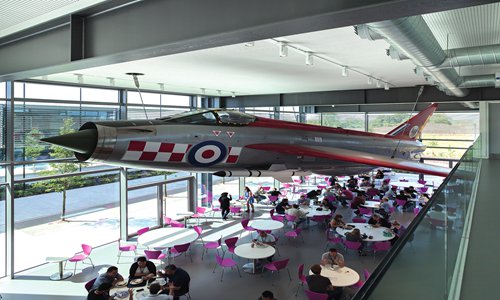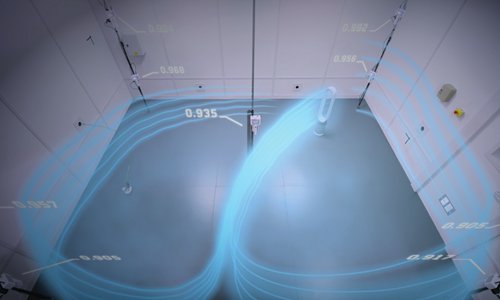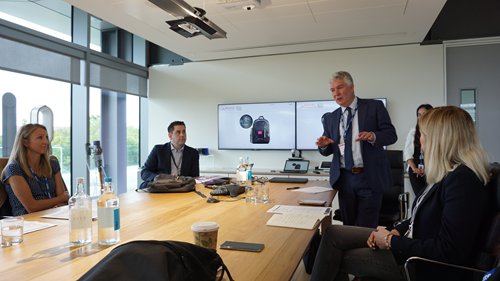HOME >> BUSINESS,METRO BEIJING
British brand Dyson thinks cool, China comes first
By Yin Yeping Source:Global Times Published: 2019/7/1 17:38:39
A tour at the heart of Dyson’s innovation

The Lightning Jet hangs on the ceiling of the café at Dyson Campus. Photo: Courtesy of Dyson

The chamber that represents the real living space Photo: Courtesy of Dyson

Experts at Malmesbury talk about the backpack program at the Clean Air Day round table. Photo: Yin Yeping/GT
Editor's Note:
All future entrepreneurship or innovation projects are driven by technological innovation. Technological innovation does not necessarily mean that one has to have a major invention but finding solutions to fulfill the needs of consumers. The British technology and innovation brand Dyson attracted consumers to its first product - the double cyclone vacuum cleaner, because it effectively solved the problem of jamming, which seemed to be the case with the "Hoover brand" and other old vacuum cleaners. Their technological and innovative solution helped them quickly become a global player. After decades of constant development, their products range from vacuum cleaners to hair care, air treatment and lighting. Dyson's products often respond to the direct public concerns about air and quality of life, and therefore have captured the hearts of consumers, especially among the middle and upper-middle class, who are more willing to pay for the premium brand. Driven by the successful standout of this technology company, the Global Times went to Dyson's heart of innovation in the UK on Clean Air Day in June to look for some clues to the brand's success.
Heart of innovation
A two-and-a-half-hour drive from London sits Malmesbury, the small town that is famous for its history. The place is famous for its Malmesbury Abbey, where the first king of England was buried in 939, making the town a famous tourist site. Yet what outsiders might not know is that the town is also home to Dyson and some 4,500 people, including James and Jake Dyson, who spend their days strategizing, inventing technology and telling the Dyson story to the world.
The Dyson Campus at Malmesbury looks like an ordinary school campus, until you enter the heart of Dyson's research and development facility where most of Dyson's cutting-edge products are designed, tested and invented before being launched into the global market.
You may come across many cool things while strolling through the site, including a Harrier Jump Jet in the parking area and a Lightning Jet hanging on the ceiling of the grand café. The site contains 129 laboratories that are host to 200 technology projects, the Dyson Institute of Engineering and Technology, and nurtures a growing population of Dyson undergraduate engineers.
Dyson has never skipped a beat when it comes to studying air. In the early 1980s, when James Dyson, the founder of Dyson, created 5,127 prototypes, his wife supported him on a teacher's salary before he eventually launched his first product, the "G-Force" cleaner. In 1993, he opened a research center and a factory in Malmesbury. Today, there are Dyson machines in over 65 countries around the world. What remains unchanged is his constant curiosity for new innovations and solutions. The only difference at this time is that he is not alone.
From outdoors to indoors
At the Dyson compound, a group of experts came up with one of their latest air quality monitoring approaches, which is how they use the back packs that are developed by Dyson's engineers to monitor the air quality and pollutants in London. Among them, there were Frank Kelly, from Kings College London and Dyson Science Advisory Board, Paul Dawson, vice president of Dyson's Health and Beauty, and Paula Radcliffe, Olympic medal winner and Dyson environmental control ambassador.
In response to the C40 Breathe London Initiative and the King's College London research program, portable air quality monitors are available at five London schools. According to Kelly, using data collected by Dyson's device in the back packs, the King's College researchers will measure the air pollution index of London children's daily commutes and analyze how human behavior changes with real-time air quality as well as discover evidence for improvement and change.
Radcliffe said that she spends a lot of time encouraging not just children but also adults to get physically active in a safe and healthy environment. "If you're doing that in a polluted environment, you're taking in four or five times of that pollution. The younger you are, the greater the volume of your lungs to your body, the more area that you require. So children are particularly vulnerable for two reasons," she said, explaining the importance of this backpack program.
In addition to the outdoor air quality, Dyson is putting a lot more attention to the indoors. "Up to now, we've had all the outdoor stuff, and we understand a lot of health effects of the outdoor stuff. But we don't really understand what we would be breathing indoors. So, that's where a lot of research is, going forward," Dawson said.
In order to capture smaller particles in homes more effectively, Dyson's R&D group has a set of tests to show how the technology works. David Hill, a Dyson's engineer at Malmesbury, said that, they developed a new test method that represents real living spaces. "We discovered that some living rooms can be as large as 27 square meters, so we made our test chamber that size, with nine sensors to continuously monitor the air quality throughout the room and map out how the room is purified," Hill said. Dyson is the only household appliance manufacturer in Europe to have its own in-house microbiology laboratory.
Eyes on China
As the major percent of Dyson's sales come from outside the UK, Asia already accounts for 50 percent of the company's profits. The biggest contributor is undoubtedly China, Dyson's fastest-growing market since 2014. With the expansion of the middle class and the rapid development of online shopping in recent years, Dyson has risen rapidly in the Chinese market.
As early as 2016, Dyson announced that China is expected to be Dyson's largest market in the next five years and the Chinese market will become the fulcrum of its globalization.
In order to capture the Chinese market better, Dyson has built a technology center in Shanghai to help people in Malmesbury understand how they can develop products for Chinese consumers and understand a bit more about Chinese homes, Dawson said.
What distinguishes Dyson's products from those of others is the technological content and industrial design of its products. "When we developed purifiers, we looked at the Chinese market and I spent a lot of time in Chinese homes to understand the pollution sources that people are concerned about," said Dawson.Every single one of Dyson's products, when they come out, will be exclusive in the eyes of the consumers. Vacuum cleaners can be wireless, no dust bags, air coolers and bladeless.
Some people often like to compare Dyson with Apple. Yet the latter's sales have seen dropping, as its products go through a process from extraordinary to ordinary.
When a brand stands at the top of its field, the problem it faces is how to overturn itself. Perhaps a sign on the Dyson Campus in Malmesbury by James Dyson already gives the answer - "Looking back gives us the confidence to look forward. Our icons, their stories, and the people behind them show what's possible when engineers think big, unconstrained by the current state-of-the-art."
RELATED ARTICLES:
Posted in: COMPANIES,METRO BEIJING